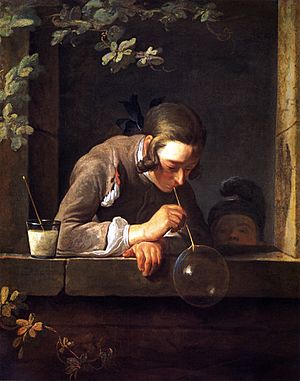Soap Bubbles (painting) facts for kids
Soap Bubbles is a famous oil painting created by the French artist Jean-Baptiste-Simeon-Chardin. He painted it around 1733-1735. The painting shows a young boy blowing a soap bubble, with another younger boy watching.
This artwork is quite large, measuring about 93 centimeters (36.61 inches) tall and 74.5 centimeters (29.33 inches) wide. You can see it today at the National Gallery of Art in Washington, D.C., USA. Chardin was known for painting everyday scenes and objects, which were very popular with people from all walks of life in France during his time. He often painted children playing.
What the Painting Shows
This painting captures a simple, quiet moment. A boy is carefully blowing a soap bubble, which floats in the air. Another, younger boy looks on with curiosity.
Bubbles: Fun and Meaning
For people in the 1700s, blowing bubbles was a fun game, just like it is today! But bubbles also had a deeper meaning. They were a symbol of how short life can be. Just like a bubble pops quickly, life was seen as something that doesn't last forever. Chardin liked this idea so much that he painted at least three, and possibly four, different versions of this "Soap Bubbles" scene.
How Chardin Made the Painting
Chardin was very careful about how he arranged everything in his paintings. In Soap Bubbles, the boys are framed by a stone window, which creates strong rectangular shapes. These sharp corners are softened by the older boy's body, which forms a triangle as he hunches over to blow the bubble. The hat of the younger boy also has a similar triangular shape.
The main focus of the painting is the round, see-through bubble itself. It shines brightly against the warm, dark brown colors in the background, making it really stand out. Chardin used light and shadow to make the bubble look real and delicate.
See also
 In Spanish: Pompas de jabón (Chardin) para niños
In Spanish: Pompas de jabón (Chardin) para niños


